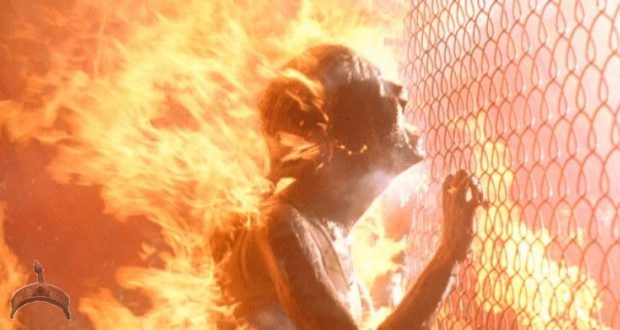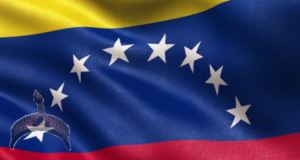by Ollie Richardson for Ooduarere via The Saker Blog
As I have now come to expect, some of the comments posted beneath my last article (and if to be honest, beneath any geopolitical article published on a so-called “pro-Russian” website) refer to an imagined scenario where human beings are just doomed – completely doomed. In context, the comments I speak of go along the lines of “Yeah, the Russian leadership might be smart, but the war hawks in the West are crazy enough to just start a nuclear war, to just press the red launch button on a whim!”. I mean, of course, nuclear weapons are a very real thing, but they are categorically not triggered by emotions. I will try to explain why.
I will started by saying that it is possible to psychoanalyse the poster of such comments and produce a fully-fledged report specific to that person, and thus save time explaining complicated phenomena in international relations. In fact, I could end this article right now, since I have already implied that a person projects his or her own internal environment onto the external world (e.g. “I’m a victim, and we’re all doomed!”). But instead I feel that it is more worthwhile and less provocative to simply explain the very basics of analysing post-9/11 geopolitics by using an example.
There are two boys of the same height and weight. Neither of them has had any professional training in any martial art or boxing. They are raw, so to speak. They are instructed by a neutral (vetted) referee to fight each other in 5 minutes, but not to kill. So we have 2 boys and 1 referee, who will only intervene if he judges that either boy is close to being killed. Both boys are checked over by the referee before the fight begins, so that neither of them has any bladed weapon or anything that may give an advantage.
Now at this stage, when an observer is asked (having seen the boys for the first time) “Who do you think will win?”, the answer isn’t exactly obvious. If this observer is asked the same question after 30 seconds of fighting, it becomes slightly easier to answer because they will have seen the boys in action, but it’s still not a fact that their prediction will come true, since their interpretation of the fighting has an element of subjectivity in it and is ultimately dependent on their level of education. For example, it would be surprising if the observer projected boy Y as the winner, having watched boy X knock boy Y to the floor 3 times in 30 seconds. It would look like the observer already had some knowledge of both or either of the boys and thus predicted that boy Y would weather the storm and come out on top.
In other words, the forecast made by the observer before the fighting has started is dependent on already-adopted scientific paradigms – such as the laws of physics, their own fighting experience, probability models, etc. They most likely would not be willing to bet their house (or mortgage) on boy X or boy Y winning, since their level of certainty hasn’t crossed the threshold established in their minds, which is also based on already-adopted scientific paradigms (do we see a pattern yet – how processes are interconnected?).
Now let’s adjust the scenario – let’s remove the referee from the equation. Now we have the same 2 boys, who are told by their class teacher (let’s just assume they are obedient pupils who will do as the teacher says) to have a fight in 5 minutes. They are not checked over before the fight – it’s possible that they could have a knife, brass knuckles, or even a gun. In this new hypothetical scenario, the observer’s position (remember: the observer is just plonked in front of the boys, they didn’t have the chance to observe them in the 5 minutes before the fight was announced and started) hasn’t actually changed, since there is an equal chance that either of them could have a weapon. If in the previous example the referee checked the boys over and, relatively speaking, gave a guarantee that both were unarmed, then in this scenario there is uncertainty vis-à-vis both of them. And after watching 30 seconds of fighting, the observer is again able to offer a more reliable prediction. It’s likely that no mortgage will be gambled here either.
In geopolitics it would seem that things more resemble the “30 seconds of fighting” scenario described above, first and foremost because we already have some knowledge of events that have happened in the past. I.e., today is not the first day we have heard about “China”, “Russia”, “Iran”, “America”, etc. However, some may already have some knowledge, but it’s not for sure that everyone will. Thus, how can it be said that someone’s 1 hour of a maths class before they dropped out of school can be equated to another person’s solid Wall Street portfolio? In other words, I am directly referring to what is coined as Wittgenstein’s ruler. One person who has observed on social media the Syrian war since the beginning may not tell the same story as another person who also observed the Syrian war on social media for the same amount of time. How accurate a story is will be discovered over time, when the same person recounts the history of different theatres (Ukraine, Libya, Georgia, etc).
So, this leads us to a question: would the observer gamble their house after watching the boys fight for 30 seconds – referee or no referee? A possible answer may be “it depends on how confident they are”. And this would indeed be true – moreover, only the observer knows for sure how confident they are. But what if they were asked “would you gamble 20 bucks?”. Of course, the stakes, and thus the level of risk, would be less. The observer chooses the wrong boy and loses $20? It wouldn’t be anything grave; it’s only a bit of beer money. Thus in this case the observer would theoretically be more inclined to gamble. And here is the first reason why the “doomsday” commenters cannot be taken seriously, because they risk absolutely nothing tangible if it turns out they are wrong. They can just post their “prophesies” like a man spreading his seed, with zero care about the consequences, enjoying not being responsible. How can anyone’s forecasts in relation to high-level affairs be believed if they don’t put something physical/of value on the line as collateral? This is a massive problem in today’s “analytical community”, where articles that offer “good” advise to governments have become an example of cyber fly-tipping.
Let us now speak in the context of today’s geopolitical reality. There are 195 countries, and the average of the size of their territory is 767,731 sq km. Real life is like Lord of the Flies, where their main aim is to survive – to eat, to drink, and to have shelter, and to pass on genes. By recognising this simple fact, which is actually just the essence of life, the observer already has a solid foundation for forecasting activities. For example, the observer can confidently ascertain that a country is not going to seek to destroy another country if the former is certain that the latter’s response will be equal in magnitude, if not more intense. History knows no example of a civilisation that consciously slit its own throat. Through costly calculations, yes, but never purposefully.
So how can a country be sure what an enemy’s response will be?
If in the past on-the-ground reconnaissance and spies were used to assess a competitor’s defence/offense capabilities, then today most of the processing is delegated to technology. Why? Because the concept of deterrence was rewritten the moment the atom bomb was invented. If in the distant past the most devastating weapon an army had was a trebuchet or longbow archers, then today it is a nuclear warhead. The difference is that with the former it was only the army that was in direct danger – troops may be killed. By the time an army had been overpowered and started to think about retreating, the enemy could pursue them and annex or raze to the ground captured settlements. The sequence of events was very linear and more serial. Today, due to the “fruits” of industrialisation and scientific discovery, the manner in which we communicate has become very truncated, and thus less time consuming. Warfare as we knew it has become something only seen in museums. No longer does country X declare war on country Y and send troops towards Y’s territory (creating a line of demarcation).
The abstract structure of a country’s response in 2019 may be (ordered from highest to lowest risk):
- Nuclear weapons – guaranteed 100% (or more) mirror damage to the enemy’s country;
- Specialised non-nuclear weapons – designed to eliminate the enemy’s army assets whilst remaining within the framework of international law;
- Regular ground forces – used to legitimately liquidate armed proxies, but not the enemy’s army;
- Public opinion influencers – tasked with socio-economically engineering, usually through state-owned media, NGOs, and general cyberspace meme campaigns.
As long as nuclear weapons remain in the arsenal of a country, a government will always prefer to exhaust the lower risk options. It must also be stressed that the damage these weapons can inflict is only imagined, for the same reason that the observer doesn’t know which boy will win the fight before it has started (no state has ever used a nuclear weapon against another nuclear state), hence why I always insist that warfare today mostly takes place in the mind (more about this later).
Let’s use a real example – the Syrian war.
America is not able to guarantee that firing a nuclear warhead at Russia will go unanswered, neither at the stage of the US missile leaving the North American continent nor at the stage when it will have hit Russian soil. In other words, Capitol Hill knows very well that in this scenario Russia would pre-emptively wipe the US off the face of the Earth. Hence why America prefers to use proxies and carry out “colour revolutions”. Putting the fact that Israel dragged the US into the Middle East aside, both Russia and America have regular troops in Syria. An agreement (or rather, concessions) was made between the US and Russia in order to keep things stable so that their respective socio-economic situations back home receive minimal damage – “we will stay on this side of the Euphrates and at Al Tanf, and you can have the West of the country”. This does not mean that Russia and America are in cahoots – on the contrary. It means that both are nuclear superpowers and both are thus unable to overpower each other. Russia would kick America out of Syria if it could. But it can’t, or to be more precise – it can, but it would be a completely pyrrhic victory.
A simple way of understanding what’s happening in Syria is to understand that a deterrent is not supposed to be used. Here is the Oxford Dictionary’s definition of this word:

But what’s going on today is much more complicated than just a child being sent to the “naughty step” every time he/she misbehaves. Of course, ideally the parents wouldn’t feel the need to punish their child in this way, so there is thus a preference to condition the child into behaving in the desired way without actually physically punishing the child, since the “naughty step” loses its scariness over time.
In geopolitics, this is where public opinion influencers come in handy. In Russia’s case, such influencers are Russia Today, Sputnik, Tass – all English-language state media. These agencies act like a mirror reflecting the West’s ugliness back at itself, highlighting the vapidity of daily life, mocking it in a way that says “Hey, you may have been told horrible lies about our country – please look at your own sh*thole before taking the bait”. RT has an operating English-language TV channel in America and Britain, and one in French based in Paris. Sputnik has a branch in most countries of the world now (by the way: a fresh neoliberal attack against Sputnik arrived on June 14th 2019). Long story short – Russia turned the West’s propaganda manoeuvres into a large Zugswang, like stepping on many rakes at the same time. Don’t believe me? Check the Internet rankings over the past 10 years. America, as was said above, uses “colour revolutions” and NGOs to achieve the same effect, although America tries to present it’s liberal media proxies as “independent”, because otherwise the US will look completely ridiculous the next time it accuses Russia of influencing this or that “democracy”.
Continuing with our Syria example, it is necessary to understand that while it doesn’t benefit America to be involved in a war of attrition in the Middle East (AIPAC is too powerful, sadly), it makes the most of the situation anyway and uses it to hurt Russia. But what happened in 2014 was very serious in terms of international security: America opened the Ukrainian theatre, which played out at the same time as the Syrian, Yemeni, Afghan, Iraqi, Palestinian, etc, and later Venezuelan one. I.e., America uses all these theatres to hurt Russia in one way or another, and to additionally complicate things, America is now obliged to hurt China too. If the objective is to give the IMF the keys to a foreign country’s central bank, the aim is always to land blows on rival nuclear superpowers. So, if to cut to the chase, America’s aim was to drag Russia into a well-prepared trap in Ukraine (the Russian army crossing the border and killing its compatriots) and prevent it from entering Syria. Hopefully, since I’ve written so much about this topic in the past, we should all be aware of how Putin skilfully dodged this bullet and created the Minsk Agreements, which allowed Russia to enter Syria by freezing the Ukrainian theatre (bringing Crimea back into the bosom of Mother Russia) and ensure that the West incurs costs as a consequence – bonjour social unrest and economic ruin due to the fragmentation of the Western bloc (US + EU vassals), aka Yellow Vests, 5 years later.
But for Russia, it’s not enough that it recovered from the damage inflicted by the CIA Gorbachev-Yeltsin fifth column and found a way to enter the centre of the great game – the Middle East – in 2015. What matters is guaranteeing the development of the state, and in order to do this the current global order, where the UN is an American puppet, needs to be overhauled. Having a comprehensive arsenal – from nuclear weapons to public opinion influencers – and the benefit of hindsight (especially in relation to what happened to Yugoslavia and Milosevic), Russia was in a strong enough position to begin this overhaul. Step 1: S-400 deployment in Syria. I wrote about the Russia-Turkey dynamic in my last article, so I won’t cover this again here, but I will, however, affirm that the likelihood of a Turkish mistake had already been taken into account by the Kremlin before that fateful day.
As a result of this miscalculation by the West, Russia is now able to go to battle in the biased UN, whilst at the same time chairing its own “UN” (military, economic, and scientific cooperation with the S-400 as the cornerstone of the new defensive-minded [multipolar] world order), which will serve as the backbone of Eurasia, regulating military reactions in accordance with international law. Now the S-400 is even in Turkey, calling this country’s NATO membership into question, and all of this happened without a single shot being fired by the Russia state at the Turkish state.
Now I want to talk about a connected topic that I have touched on before, but not in detail, because it’s so complicated that I hadn’t yet found a simple and digestible way to explain it. Recall that in the past I have spoken about supercomputers, or more precisely – the Russian Ministry of Defence’s. As a reminder, here is the proof that is exists, and here is a key quote (emphasis my own):
“A ‘colossally powerful’ supercomputer installed at Russia’s military headquarters helps the country’s armed forces tackle emerging threats by analyzing previous conflicts, such as the Yugoslavian war and the like, Defense Minister Sergey Shoigu said.”
And yes, Russia deliberately flaunts its assets so that all parties understand intentions. You might ask “But the Pentagon surely uses one too, right?”, and the answer to this would be in the affirmative. Take a look:
As we can see, the description says:
“…Sierra is purpose-built for an entirely different mission: nuclear weapons.”
So we can see that the little schematic for the structure of a country’s arsenal I wrote above, consisting of 4 points, isn’t that far from reality, even if it might seem extremely oversimplified. The purpose of these supercomputers is to give the Russian Ministry of Defence/Pentagon a range of options vis-à-vis the great game. In essence, the use of nuclear weapons will only happen if the sender can be sure that the enemy and its allies will not strike back. Hence why America has only bullied Africa states up to this point, since the operations to conquer these lands don’t demand the use of Enola Gay 2.0 – the simple aircraft carrier plus proxies combination has been able to get the job done up to this point.
And it should also be mentioned that the EU (which today essentially represents German, not US, subordination) also is obliged to have a supercomputer, since America just withdrew from the INF treaty (and Trump in general would benefit from the EU’s disintegration), thus throwing Berlin under the bus.

I myself am certainly not a mathematician, and so I never dared to even write a simple equation that the supercomputer’s algorithm may use.However, recently I discovered an academic piece of work that opened my eyes to what Russia is perhaps capable of.
The document is 7 pages long (I have a full copy), and the Internet preview shows only the first 2 pages, but for the purposes of this article I think that this will be sufficient enough. So what is it? It is a scientific piece of research entitled “A Model of Information Warfare in a Society Under a Periodic Destabilizing Effect” and was produced by 3 different Moscow universities (published in 2016). In basic terms, Russian scientists created algorithms to explain how information is disseminated, and conclude that “a short-term increase in the propaganda intensity does not have long-term consequences”. Here is an example equation from page 4:

It’s complicated? That would be an understatement.
Why is this relevant to nuclear doctrines? Because modern warfare is based on calling perceived bluffs. Similar to how we don’t know for sure if a man who walks down the street with his hands in his pocket is concealing a gun, the deployment of a military unit to a certain zone can either be carried out in the name of an “exercise” (bluff) or preparation for an actual hybrid provocation (like the US’ downing of MH17 via the Ukrainian Army’s hands to justify the sanctions – which in reality are anti-German – policy).
Russia needs (and has) the corresponding tools in order to probe adversaries and remain one step ahead not only on the physical battlefield, but also in the cyber battlefield. And it is thanks to these tools that Russia managed to prevent what would have been the 3rd bombing of Syria by the US, in 2018. The mainstream media was already broadcasting the White Helmets propaganda videos, showing “bombed hospitals” and “Assad barrel bombs”, and paving the ground for more US/French/UK bombing (Trump needs these occasional controlled strikes in order to soften up his own domestic position and to economically blackmail Russia vis-à-vis other theatres). But the Russian media, in response, kept repeating “the White Helmets have begun filming a staged chemical attack”. America even sent a warship to the Syrian coast to make the threat credible, but it turned out to be a bluff, because Russia outmanoeuvred the US in the information space, having learnt from the previous 2 instances, by making any attack completely useless (“We predicted you’d stage a gas attack, and one actually happened, so now ordinary laypeople will not swallow the ‘bad Assad’ pill, and may even start to question the MSM narrative more”).
So in short: the Ministry of Defence’s supercomputer helped Putin to keep the US (and Israel) on the ropes and prevent the domestic situation from deteriorating (America wants Putin to look weak in front of his own people, paving the way for a coup d’état; the Nemtsov false flag was a failure since society did not come to the streets).
I am not trying to say that specifically these scientists wrote the algorithm of the Russian Ministry of Defence’s supercomputer. What I am trying to say, however, is that we can see a real life example of what work the Russian scientists are doing within the framework of “hybrid war”, and can thus use it to at least imagine what is going on in the defence industry. And, most importantly, it’s possible to explain to the doomsayers that international relations does not work like a light switch – on/off. The responses available to a nuclear superpower – whether it be Russia, China, or the USA – are much more diverse than just “bomb” vs “don’t bomb”. As we have seen, the main weapons of the US are armed proxies, a cyber fifth column, and sanctions. And at no point during the last 10 years have things escalated beyond point No. 3 (the use of regular ground forces in the framework of proxy warfare) in the schematic outlined above. Everyone wants to survive, remember?
Lastly, the media – both mainstream and independent – in general likes to exploit fear porn to increase the number of clicks and advertisement revenue. They will say “War with Iran around the corner”, and then the following week report “Trump imposes more sanctions on Iran”. A good general rule is that if a website tries to convince you that war is days away, then it is safe to say that it’s nonsense. In fact, the Internet “news” space has in general become a parallel universe, where we now have so-called “deep fakes”, which testifies to the increasingly complex task of algorithm creators. I will end this article with two quotes from Jean Baudrillard’s book “Simulacra and Simulation”, which I feel express very well the nature of today’s “hybrid” warfare:
“We live in a world where there is more and more information, and less and less meaning.”
“It is dangerous to unmask images, since they dissimulate the fact that there is nothing behind them.”
 Ọmọ Oòduà Naija Gist | News From Nigeria | Entertainment gist Nigeria|Networking|News.. Visit for Nigeria breaking news , Nigerian Movies , Naija music , Jobs In Nigeria , Naija News , Nollywood, Gist and more
Ọmọ Oòduà Naija Gist | News From Nigeria | Entertainment gist Nigeria|Networking|News.. Visit for Nigeria breaking news , Nigerian Movies , Naija music , Jobs In Nigeria , Naija News , Nollywood, Gist and more








